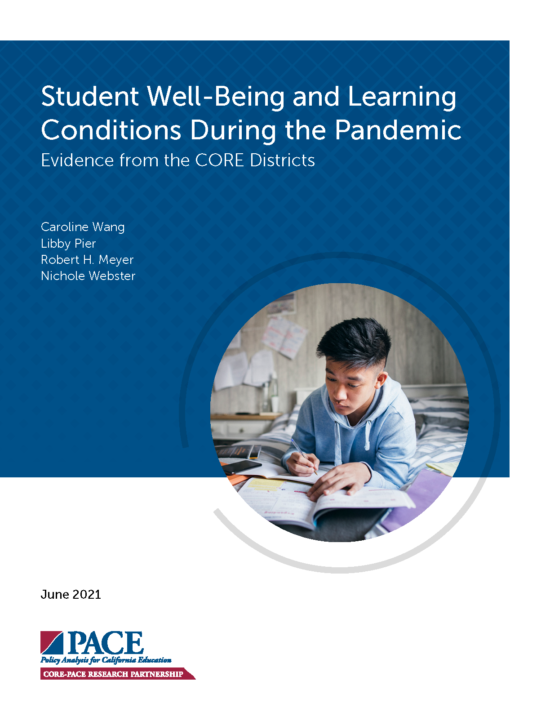Student Well-Being and Learning Conditions During the Pandemic: Evidence from the CORE Districts
Caroline Wang, Libby Pier, Robert H. Meyer, & Nichole Webster
Since spring 2020, the COVID-19 pandemic has been abruptly interrupting regular instruction in almost all schools in the U.S. One year later, policymakers, district administrators, and educators are still balancing the benefits and risks of returning K–12 students to fully in-person school. Many are concerned about the pandemic’s disruption to students’ academic progress. In California, educators have been focused equally on students’ mental and emotional health, social relationships, and learning environment, given that many students have been learning remotely since the onset of the pandemic.
Anticipating the need for schools and districts to understand their students’ social-emotional well-being, the CORE Districts in California developed survey instruments to collect such information in the 2020–21 school year. The surveys were administered remotely, as all participating districts offered distance-only instruction. In this report, we draw on data from the Student well-being and learning conditions diagnostic survey taken by 32,000 students in Grades 4–12 from three districts at the beginning of the 2020–21 school year. We then highlight results from 15,000 students who also responded to the Comprehensive interim survey a few months later.
Results showed that students generally rated their learning environment at school (in 2019–20, before school closures) and learning environment online (in spring 2020, after school closures) relatively highly and consistently across grades. However, students had relatively lower ratings for their personal and interpersonal well-being. Students’ responses varied across grades; we discovered different response patterns between boys and girls, English learners and non-English learners, and students with and without disabilities. When connecting students’ well-being with academics, we found that secondary school students’ interpersonal well-being was most correlated with academic achievement. Middle schools at which students reported higher interpersonal well-being also tended to have higher academic achievement in fall 2020 and higher academic growth from fall 2019 to fall 2020 on average.
Comparing responses between fall 2020 and winter 2020–21, students’ home/online learning environment consistently improved across grades. This is a testament to the efforts of administrators, educators, families, and parents to improve online learning experiences for students throughout the 2020–21 school year. However, likely due to the continuation of remote learning, students in Grades 5–12 reported that they did not like school as much in winter 2020–21 compared with how they had felt at the beginning of the school year. This report brings data to bear on the areas of student well-being that are most relevant at each developmental stage, so that all education stakeholders are able to focus their efforts on meeting the most pressing needs of each group of students.
